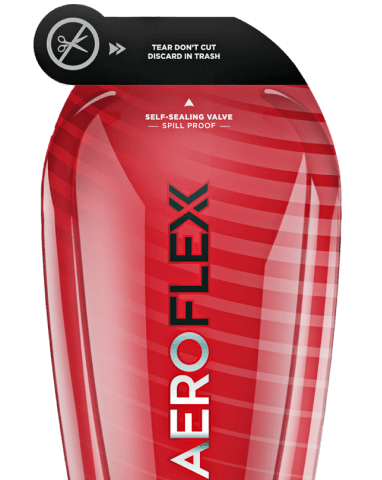Summary
The challenge of shipping liquids in e-commerce is a massive profitability and reputation risk for brands, far beyond a simple customer service issue. Traditional rigid packaging frequently fails due to pressure changes and weak seals, leading to damaging leaks that ruin products, drive up costly returns, and erode customer trust. To compensate, brands resort to excessive secondary packaging, which spikes shipping costs and creates a wasteful, frustrating unboxing experience. The solution lies in purpose-built, omnichannel-ready packaging like the AeroFlexx Pak, whose durable, flexible design eliminates the need for bulky fillers, minimizes breakage, and is certified for prep-free shipping, instantly cutting costs while delivering a flawless, positive experience.
You’ve probably seen it (or worse, experienced it): A customer opens a long-awaited delivery only to find that their shampoo bottle leaked during transit, soaking the rest of the box. The packaging is a mess. The product is unusable. And the customer’s impression of the brand is ruined.
As more brands shift to direct-to-consumer (DTC) models and expand global fulfillment networks, the complexity of e-commerce shipping has skyrocketed. Add in rising consumer expectations—faster delivery, minimal waste—and the pressure is even greater. For liquid products, this challenge is especially tough. What seems like a small leak can turn into a costly loss, damaging not only the product but also the brand’s reputation.
This isn’t just a customer service issue. It’s also a supply chain and profitability problem. Each leaky package means replacement costs, shipping fees, and a potential lost customer. To stay competitive, brands need packaging that can safely ship goods through e-commerce channels while delivering a seamless, positive experience to the consumer.
Today, leakproof, consumer-friendly packaging that can be shipped with little to no risk of damage is a business necessity.
Top 5 Pain Points of Shipping E-Commerce Packaging
For brands that ship liquid products, the real costs of poor packaging often stay hidden—until they start stacking up. Returns and replacements, customer service labor, and damaged inventory all chip away at profits. Plus, the long-term impact—brand erosion, negative reviews, and customer churn—can be even more damaging.
Let’s take a closer look at the top challenges brands face when shipping liquids through e-commerce channels:
1. Leakage and Breakage
Pressure changes during transit, weak seals, and brittle containers are common culprits when it comes to leaks and breakage. The consequences are familiar and costly: product damage, order returns, negative reviews, and long-term brand perception issues. Even a minor leak can lead to full order loss, with products in the same box soaked or ruined. For customers, it’s a frustrating experience. For brands, it’s a liability.
2. Excessive Secondary Packaging
To compensate for fragile or leak-prone packaging, many brands turn to bubble wrap, shrink bands, and layers of packaging fill. While these may offer short-term protection, they increase material use, and this added bulk drives up shipping costs. They also create a poor unboxing experience that feels excessive and environmentally irresponsible, which can make more eco-conscious consumers turn away.
3. Regulatory Mandates
Shipping liquids domestically and internationally involves navigating complex compliance requirements, from hazmat classifications to labeling and packaging standards. The operational burden on brand teams is significant. Missteps can lead to delays, fines, or returns. The time and resources required to manage these missteps is more than most realize.
4. Weight and Shipping Costs
Liquids are heavy to begin with, and when combined with bulky secondary packaging, they quickly push weight and shipping fees upward. These increased costs cut directly into profit margins, making even successful deliveries more expensive than they should be.
5. Consumer Expectations and Experience
Today’s consumers expect fast, flawless deliveries, and they have little patience for damaged orders. One bad experience can lead to churn, a lost customer lifetime value, or a public complaint. In a competitive market, trust is hard-won and easily lost. Packaging that fails in transit can damage both the product and the customer relationship.
AeroFlexx: A Low-Risk, High-Impact Solution for CPG Brands
Solving the pain points of liquid e-commerce packaging doesn’t have to mean overhauling your entire operation. With AeroFlexx, consumer packaged goods (CPG) brands can adopt a packaging solution that delivers immediate impact without adding risk. In fact, we offer brands a trial of the AeroFlexx Pak before they commit.
The Pak is designed specifically for the demands of omnichannel fulfillment, helping consumer product brands reduce costs, improve customer experience, and future-proof their packaging strategy.
Here’s how:
Durable, Flexible Design
The Pak is ISTA-6 Amazon approved for ships in own container, which means it can be placed in an envelope or box and shipped easily. Its durable, flexible structure eliminates the need for excessive secondary packaging, leading to fewer damaged orders, fewer returns, and higher customer satisfaction.
Omnichannel-Ready
AeroFlexx enables brands to use a single stock-keeping unit (SKU) for both e-commerce and retail sales, simplifying logistics and cutting down on packaging variations. This not only reduces SKU proliferation but also helps brand and operations teams meet their efficiency, inventory, and fulfillment goals.
Built for Safety and Hygiene
With a tamper-proof valve design and no need for separate caps or pumps, the Pak enhances product integrity while offering a more hygienic, consumer-friendly experience. It’s packaging that delivers peace of mind for both brands and their customers.
Drives Real Cost Savings
By reducing return rates, minimizing packaging materials, and lowering labor costs associated with fulfillment, the Pak helps brands protect their margins. Fewer compliance chargebacks and operational headaches make it a smart choice for CPG teams focused on the bottom line.
Supports Sustainability and Brand Innovation
The Pak’s eco-conscious design uses less plastic, reduces waste, and aligns with the values of today’s environmentally aware consumers. It offers brands a way to innovate packaging without taking on the risks typically associated with change.
Ready to See How the Right E-Commerce Packaging Can Drive Growth?
Download our free e-book, Transforming Packaging into a Strategic Growth Driver, and discover how leading brands are rethinking packaging to improve performance across the entire value chain.







